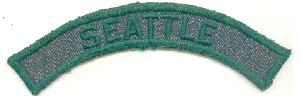Vintage Girl Scout Online Museum

Home | Email | Site Map | Updates | Girl Scout Badges, et.al. | Girl Scout Pins | Girl Scout Uniforms | Girl Scout Cookies | Girl Scout Garden
Girl Scouts on the Move | National Girl Scout Patches | Girl Scout Troop Crests | Girl Scout Library | SCOUTOGS | Girl Scouts in the Kitchen
Girl Scout Beauty Kits | The Art of Being Girl Scout | Girl Scout Jewelry | Girl Scout Hobbies & Collectibles | Senior Girl Scout Roundups & More
Girl Scout Camp Equipment | Girl Scout Special Days & Special Ways | Girl Scout vs The Law | Girl Scout Landmarks | Girl Scout Sewing Nook
Girl Scout Dolls, Figurines & Plushies | The Girl Scout Creed | "A Girl Scout" | Things that aren't Girl Scout
Girl Scouts Being Outdoors | Girl Scouts - A Call to Service | Girl Scout Mystery Stuff
A Girl Scout is Thrifty | Vintage Senior Girl Scout Programs | The Girl Scout Armoire
Girl Scout Uniforms
1939-1948

This era in Girl Scouting reflects the tremendous growth in the program before, during and after World War II. The Intermediate level got a new uniform design and many new badges. The new "Senior" level had plenty of new options to keep them busy. War-time restrictions brought creative adaptation.
This is just a brief overview of the era and doesn't note every detail.
Grey-Green
1928-1938
Silver-green
1939-1948
Bright Medium Green
1948-1960


Side-by-side comparison of the fabrics used in Girl Scout uniforms and badges.


1939
1943
In response to the restrictions on metal in
World War II,
the Intermediate uniform dropped the zipper and changed to a button-up style in 1943.




The Curve Bar became the highest rank in Girl Scouting in 1938.

World War II era Service Bureau Pin

It should be noted that up until the 1939 design change in the Intermediate Girl Scout uniform, that the uniforms could be also worn as street-wear by changing out the buttons and removing badges, etc. This was to be expected, as any investment in clothing was meant to be worn thoroughly, and passed down if possible.
In 1939 the collar of the Intermediate uniform had the "GS" embroidered on it, rendering it to Girl Scout uniform wear only. The new Senior Girl Scout uniform still promoted that it could worn on "dates" - meaning that any GS identification could be removed. This changed with the 1943 Senior Girl Scout uniform that earned emblems to be stitched on - ok - technically it was the Spring of 1942 that offered the first Senior Scout Service emblem that could be stitched on.



First offered in 1935 the two piece uniform went from the 'Teen-Age uniform for girls who wanted a more mature looking uniform, to "Light Weight Uniform" for Intermediate Girl Scouts, summer wear or those in warmer climates, as the Senior program was launched with their own uniform.
The short-sleeved version of this two piece uniform necessitated the invention of the badge sash.
1938 brought about the council identification strip. Some ID strips have been found in the older grey-green fabric, but most are in the silver-green fabric of this era.














1939
Butterick Sewing Patterns for
Girl Scout uniforms

1943




This sorority inspired new style of membership pin for Senior Girl Scouts was tiny, only 1/2".
1938-1963

The Wing Girl Scout program
took flight in 1941. It did not
have an official uniform, unlike
the Mariner Girl Scouts. However,
the new Senior uniforms certainly
fit the bill. The new manual was issued in 1945.

This version of the Senior Scout Service patch came in 2 sizes; large for uniform or armband (shown below) and small for use on the hat. This design was only official for the Spring of 1942, and was quickly altered for the Fall of 1942. The white triangle on a blue circle was the symbol for the Civil Defense (1939) and Girl Scouting probably didn't have permission to incorporate it in their Senior Scout Service patch.

Girl Scout Hospital Aide patch





1943
1943
Intermediate Girl Scout web belt and buckle
The Mariner Scout program had several uniform components; middy, skirt, sweater, long pants & shorts.
Mariners Scouts could also fulfill the requirements the Senior Scout Service and wear the emblems on their uniforms.

During war-time metal rationing, Girl Scouting could still sell the metal Mariner pins they had in stock, but they also offered a rayon-based pin as a substitute.
The Altvaters
By 1947, the Mariner Scout skirt had lost it buttons.

1946 brought back the metal Mariner Scout pin,
freshly redesigned.


1938 - the Mariner Scout 5-bangle bracelets - 35 cents

1940 - Mariner Handbook


The "G.S." collar pins were eased in during the end of the last era in adult uniforms, but common on adult uniforms of this era. There are 2 other versions; without the metal strip between the G & S, and one with loops for stitching onto the collar.


Although the adult Girl Scout uniform changed in 1939, it wasn't often shown in the GS catalogs of the era. The military-look was very popular and is reflected in the uniforms.
...